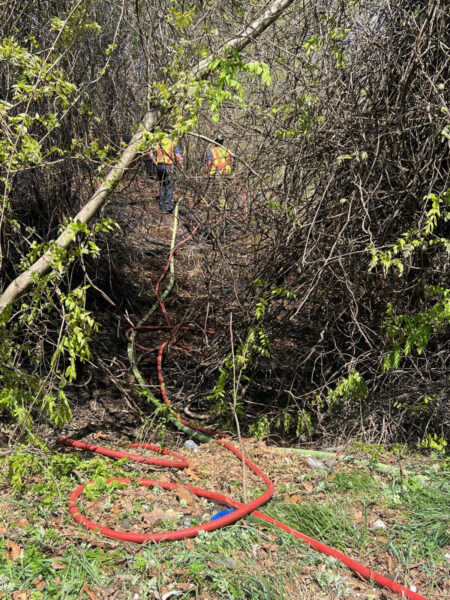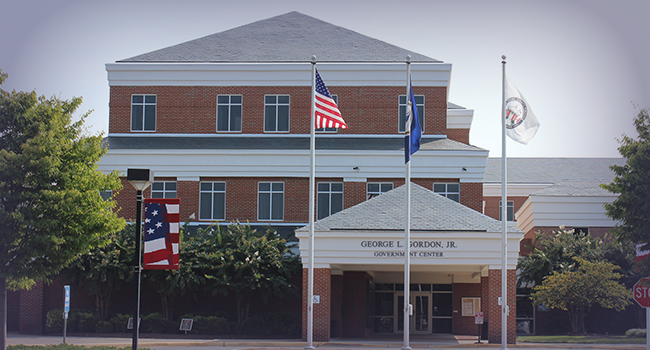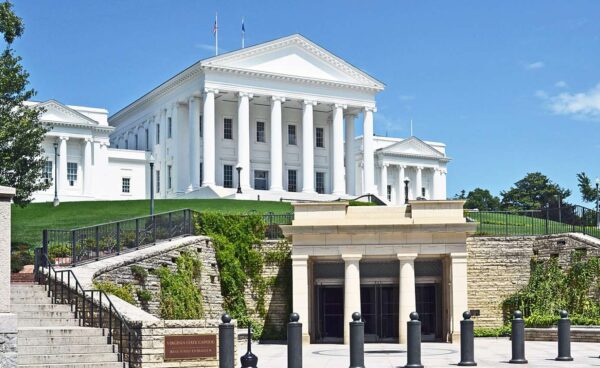
Fredericksburg Free Press – Community leaders and local officials in the Fredericksburg area are grappling with how to protect undocumented immigrants in the context of mass deportation efforts directed by President Trump and enforced by U.S. Immigration and Customs Enforcement (ICE).
One aspect of the president’s new border policy is particularly troubling to some in the Fredericksburg area — the removal of the protection of migrants at schools, churches and hospitals.
This article is FREE to read. Please Sign In or Create a FREE Account. Thank you.

Inspired by the devastating wildfires in California that have affected over 38,600 acres and led to evacuation orders for 88,000 residents as of Jan. 15, we reached out to Stafford County’s Fire and Rescue team to explore how they get ready for wildfires in this area.
A wildfire outbreak began in California on January 7, 2025 and continues as of Jan., 23. Over 47,000 acres have burned, with a new fire starting yesterday in Hughes County. Over 16,000 structures have burned due to wildfires in 2025.
Katie Brady, county fire department spokeswoman and Fire Life Safety Manager, clarified that “wildfire” is a broad blanket term. Stafford is likelier to experience “brush fires” than quick-moving wildfires that cause widespread destruction like California’s. Brushfires can range in size from a few feet to several acres and can be precursors to a larger wildfire capable of causing significant damage. Brushfires are more common when the area experiences drought conditions, like in 2024.
Brady credited those drought conditions with the increased fire activity in Stafford. The area saw brushfires along I-95; one day in March, she said, several brushfires were held in Stafford and around the Commonwealth. With brushfires, responders must monitor humidity levels and the speed and direction of wind in order to minimize the spread.
While the risk of brushfires in this area is low, Brady said fall and spring are typically higher-risk seasons, but brushfires can break out at any time of the year.
Brady highlighted the importance of following burn bans and burn laws, encouraging residents to dispose of charcoal and cigarette butts in fire-safe containers, closely tend to any open flames, and make sure they have “30ft of “defensible space” around structures. Creating defensible space includes clearing yard debris like dead trees or limbs, large bushes, and leaves away from their homes, garages, and barns.
The National Fire Protection Association (NFPA) suggests keeping the first five feet closest to a home or structure clear of flammable materials such as wood mulch, leaves, pine needles, and wooden furniture. They also encourage maintaining the structure by replacing shingles and broken siding and keeping decks, carports, and garages in good condition to minimize the chance of embers entering the space and igniting a fire.
NFPA says the space five to thirty feet from the home should minimize or delay the spread of any fires. Adding cement, dirt, or stone surfacing and breaking up landscaping can help slow fire spread.
The caller’s information determines the fire department’s next steps when a fire is reported. The number of units responding and the type of fire vehicles are based on the information provided by the caller and water availability in the area. The first vehicle on the scene is responsible for assessing the situation and calling in any additional support.

Brady said Stafford County has five brush trucks and five tankers; brush trucks are smaller, which allows them to reach more challenging locations. Tankers move more significant amounts of water to areas without easy access to hydrants, and the Department of Forestry can also provide additional support if needed. Responders also continually monitor the situation to determine if evacuations may be necessary.
Brady said the goal in responding to brushfires is to contain and extinguish the fire quickly. Using hand rakes and digging fire lines helps contain the spread of the fire; in areas with rugged terrain, the department may borrow bulldozers from the Department of Forestry to cut fire lines.
Stafford firefighters all train with brush trucks and learn brushfire management tactics. They also have continuous training on managing rural water supply issues, such as when they must secure water sources in areas without fire hydrants.
Stafford County also coordinates with local, state, and federal agencies to coordinate planning and training for all emergencies and establish public communication and methods for requesting additional resources or equipment when needed. They can partner with other agencies in the event of a more significant fire in the area and send Stafford firefighters to different places in need.
In March 2024, Stafford sent two brush trucks to assist Page County during an outbreak of fires across the Commonwealth. In 8 days, 92 wildfires burned over 12,700 acres across Virginia.
 Germanna Community College (GCC) hosted a ribbon cutting at its new Stafford expansion today, January 23, 2025. The event marked the opening of two buildings in Stafford: the Barbara J. Fried Building at 10 Center Street and the Kevin L. Dillard Health Sciences Building at 25 Center Street.
Germanna Community College (GCC) hosted a ribbon cutting at its new Stafford expansion today, January 23, 2025. The event marked the opening of two buildings in Stafford: the Barbara J. Fried Building at 10 Center Street and the Kevin L. Dillard Health Sciences Building at 25 Center Street.
GCC was established in 1970 as part of Virginia’s Community College System and has locations in Culpeper, Locust Grove, Fredericksburg, and Stafford. The school's website says over 13,000 students are enrolled.
The new expansion added 74,000 square feet to the campus with a $20 million investment. GCC plans to double enrollment in allied health services, like nursing. They will also expand their cybersecurity, IT, general education, and dual enrollment programs.
This article is FREE to read. Please Sign In or Create a FREE Account. Thank you.
A debate over proposed legislation targeting panhandling in road medians sparked a spirited discussion among Stafford County Supervisors during their January 21 meeting. The proposed bill, sponsored by Delegate Paul Milde (R-64, Stafford County), seeks to impose fines on motorists and pedestrians who exchange items in roadway medians to improve safety and reduce traffic disruptions.
The legislation was also a topic of discussion on the Potomac Local News Podcast, where Milde elaborated on his rationale behind the bill in an interview with Publisher Uriah Kiser.
Safety and Traffic Flow Concerns
During the podcast, Milde emphasized the safety and traffic issues posed by panhandling in medians.
This article is exclusively for our Locals Only members. Please Sign In or upgrade to become a Locals Only Member today!
Your support helps us continue delivering more in-depth community news that matters to you.

As Arctic air brings frigid temperatures to the region, multiple school districts have announced schedule adjustments for Thursday, January 23, 2025:
- Stafford County Public Schools: 2-hour delay.
- Spotsylvania County Public Schools: 2-hour delay. Twelve-month and essential employees report on time as safety permits. All other employees report two hours late.
- King George County Schools: 2-hour delay.
- Fredericksburg City Public Schools: 2-hour delay. Employees should report two hours late.
Weather Forecast from the National Weather Service
This article is FREE to read. Please Sign In or Create a FREE Account. Thank you.

Janet Brown was appointed Stafford County’s citizen representative to the Central Rappahannock Regional Library Board following a unanimous vote by the Board of Supervisors during their January 21, 2025, meeting. Brown’s appointment comes as the county looks to strengthen ties with the regional library system and improve its collaborative efforts to enhance library services.
Brown, a longtime Stafford resident and active community member, brings a wealth of experience in civic engagement and public service. “I am honored to represent Stafford County and look forward to working with the library board to ensure our community has access to the best resources and services,” Brown stated following her appointment. Her term will begin immediately.
The appointment follows a challenging period for the county’s relationship with the library board. During the same meeting, Chairman Deuntay Diggs issued a public apology to former library board member Mary Becelia, who was removed from her position under allegations of misconduct.
“On behalf of the Board of Supervisors, I extend my deepest apologies to Ms. Becelia for the hardship and embarrassment she has endured,” said Diggs. “We acknowledge the impact this has had on her personal life and family and are committed to fostering a better environment of trust and collaboration moving forward.”
Diggs further emphasized the board’s intention to address procedural shortcomings to prevent similar situations. The matter will be reviewed during a January 28 work session.
The Central Rappahannock Regional Library serves Stafford County and surrounding areas, providing the community with critical educational and cultural resources. With Brown’s appointment, the county aims to turn the page on recent controversies and reaffirm its commitment to the library system’s mission.
This development follows the December 17, 2024, formal censure of Stafford County Supervisor Monica Gary, who represents the Aquia District, for removing Mary Becelia from the Central Rappahannock Regional Library Board of Trustees. The board accused Gary of providing misleading information that led to the unjust ousting of Becelia and violating the board’s Code of Performance. As part of her punishment, Gary was removed from all board assignments and committee appointments.
The censure resolution, passed by a 5-0 vote with one abstention, stated that Gary’s actions were “political in nature” and aimed at securing support from the Stafford Democratic Committee for her 2025 re-election bid. Gary, a one-term supervisor who ran without political affiliation, has announced her intention to seek another term representing the Aquia District.
Gary has announced she will not seek re-election after her term ends on December 31, 2025.
During the meeting, Gary defended herself, accusing her colleagues of retaliation and alleging violations of federal and state laws. “This is retaliation, it is illegal under federal law as it was when I was removed from the library board for making my colleagues look bad,” Gary said. “This is an abuse of power, and if I have to be the only person to stand up here and deal with it, I’m happy to do that.”
Gary further accused the board of damaging public trust. “The public doesn’t trust because this board is not trustworthy and has shown themselves not to be so. What we’re witnessing right now is an abuse of power,” she stated.
Garrisonville District Supervisor Dr. Pamela Yeung, who abstained from the censure vote, expressed regret over the situation. “Two wrongs don’t make one right,” Yeung said. “I regret that this mistake happened, but I’m not voting to remove Supervisor Gary because I believe that was a necessary decision to remove her from the library board itself.”

Funeral services for Robert “Bob” C. Gibbons, a former member of the Stafford County Board of Supervisors, will be held on Friday, January 25, 2025, at 11:30 a.m. at St. William of York Catholic Church, located at 3130 Richmond Hwy, Stafford.
Gibbons, who recently passed away, dedicated more than 34 years to serving the citizens of Stafford County, leaving an indelible legacy of leadership and commitment. He represented the Rock Hill District on the Board of Supervisors from 1991 to 2007, serving multiple terms as Chairman and Vice Chairman.
In addition to his time on the Board, Gibbons served on the Board of Zoning Appeals for four years and the Utilities Commission for two years. His contributions extended to the Planning Commission during two different periods, where he championed key initiatives, including the Transfer of Development Rights Program, the expansion of Transportation Impact Fees, and the creation of a Historic Interpretive zoning category.
“Bob Gibbons exemplified dedication to Stafford County,” said Chairman of the Board of Supervisors Deuntay Diggs in a press release. “His passion for education, libraries, and community advancement inspired those who worked alongside him. On behalf of the Board and the citizens of Stafford County, I extend our heartfelt condolences to his family and gratitude for his years of service.”
Gibbons was known for his ability to listen and apply community feedback to local government objectives. Even after his time in office, he and his wife Lois remained involved in the community, frequently attending ribbon-cutting ceremonies and special events, reflecting their deep love for Stafford County, the press release states.
Additional information is available at the Covenant Funeral Service website.

- [Bee Calder via Unsplash]
Monday was the late Martin Luther King Jr.’s birthday, and many local governments and organizations closed in honor of the civil rights leader’s service. Here’s how they, along with elected officials, honored him on social media.
Today we commemorate Dr. Martin Luther King’s life and the positive impact his legacy continues to have on so many. We remember him for his timeless values and vision that should be celebrated and embraced every day. #MLKday pic.twitter.com/cRr5IkUBnN
— Virginia American Water (@vaamwater) January 20, 2025
Happy MLK, Jr. Day! ? Today, we honor the legacy of Dr. Martin Luther King, Jr. as we reflect on his impactful work for civil rights and equality. Stafford Gov. offices and courts are closed. Landfill is open. More: https://t.co/TvtoK7VSxa #MLKDay
— Stafford County (@staffordvagov) January 20, 2025
Celebrating the legacy of Dr. Martin Luther King Jr. not just today but every day: “The ultimate measure of a man is not where he stands in moments of comfort and convenience, but where he stands at times of challenge and controversy.” pic.twitter.com/pLSUXqlrNf
— Fairfax County Government ?? (@fairfaxcounty) January 20, 2025
Today, let’s celebrate the life and legacy of civil rights leader Martin Luther King Jr. pic.twitter.com/5FJvX4UtuZ
— Loudoun Co. Govt. (@LoudounCoGovt) January 20, 2025
? Today, we honor the life and legacy of Dr. Martin Luther King Jr. — a leader whose vision of equality, justice, and unity continues to inspire us all.
Let’s celebrate his dream by spreading kindness and standing for justice and equality while building even stronger Town. pic.twitter.com/XMcXD7zrD8— Dumfries, Virginia (@DumfriesTownVA) January 20, 2025
Honoring Dr. King’s legacy reminds us of his commitment to justice, equity, & service. Service means ensuring no one is left behind. In Prince William County, let’s continue building bridges and supporting those in need. “The first function of community is support.” – MLK #MLKDay
— Andrea Bailey (@AndreaBaileyVA) January 20, 2025
Prince William County honors the legacy of Dr. Martin Luther King, Jr.
“Life’s most persistent and urgent question is, ‘What are you doing for others?’” – Dr. Martin Luther King, Jr. pic.twitter.com/JbIpXJxg5g
— Prince William County (@pwcgov) January 20, 2025
In honor of #MLKDay, our office is closed to reflect on Dr. King’s legacy. Together, we strive for justice and equality for all. ?? Visit https://t.co/F1Fp4AxxAF for regular hours! #JusticeForAll ? pic.twitter.com/imQoH5ojpL
— Jacqueline Smith, Clerk of Circuit Court (@PWCCircuitCourt) January 20, 2025
One of my favorite quotes from Dr. Martin Luther King, Jr. is, “The arc of the moral universe is long, but it bends toward justice.”
Today, we can honor his legacy by working to build a more just future.
Because while progress takes time, it is always worth fighting for. pic.twitter.com/iG84DHFfax
— Eugene Vindman (@YVindman) January 20, 2025
Today, we honor Dr. Martin Luther King Jr.’s unwavering fight for justice and equality. Let his dream inspire us to build a more just world. pic.twitter.com/0xBG6ye43s
— Rep. Suhas Subramanyam (VA-10) (@RepSuhas) January 20, 2025
— Mark Warner (@MarkWarner) January 20, 2025

With the swearing-in of Donald Trump as America’s 47th President on Monday, considering the new administration, we asked some of the Fredericksburg area’s elected representatives about their visions for 2025.
Senator Mark Warner (D) said:
“I’ve been proud to be a member of many bipartisan gangs during my time in the Senate. In fact, it’s through bipartisan work that we managed to tackle COVID-19, fund our national parks, bring back American manufacturing, fuel investment in underserved communities, and so much more. It’s my priority to ensure that this bipartisan work continues – even under a Trump administration. As we dive deeper into the 119th Congress, I’m looking forward to defending and building on the progress we made under President Biden. To do that, I’ll continue to work with anyone who has a good idea, regardless of party affiliation.”
Senator Tim Kaine (D) released a statement online on January 3:
“I’m so grateful for the opportunity to serve Virginians for another six years. I’m proud of what we’ve done so far to lower health care costs, rebuild our nation’s infrastructure, protect our national security, and grow our economy by bringing new investments to Virginia. I look forward to building on this progress together. I know that for many Virginians, the new Administration brings uncertainty and even fear, but I will always fight to build a brighter future for all Americans—no matter who you are, who you love, what you look like, how you worship, or what your economic status is. I’m excited to continue traveling across the Commonwealth and working together to strengthen our economy by lowering costs, expanding access to job training programs, and making it easier for families to access affordable child care. I will also keep seeking common ground to support Virginia’s servicemembers and meet our defense needs, and make progress on commonsense immigration reform, gun safety legislation, and more.”
Congressman Eugene Vindman (D) released a Jan. 2 statement in which he said:
““I am honored and humbled to officially begin serving the people of Virginia’s Seventh District in the U.S. House of Representatives. In Congress, I will fight to keep the promise of America alive for everyone across the Commonwealth and our country……
I want every working American like my Dad to have the chance to live their American Dream, and I will fight everyday for families and workers chasing the Dream. That work starts by working across the aisle to lower costs, improve public education, and protect our most basic rights and freedoms.
I am optimistic that my colleagues and I will find bipartisan solutions by listening to constituent concerns, responding with pragmatic legislation, and delivering real results for communities across the Seventh District and the nation…”
Delegate Joshua Cole (D) said:
“As we prepare to start 2025, my focus and vision, specifically for the 65th District and the greater Fredericksburg area, is to make sure we prioritize our working families and the families most vulnerable among us. Ensuring well-paying jobs are coming to the region, access to affordable housing, and boosting our local schools.”

